Recent Storm Damage Posts
4 Home Flood Water Preparations That Make Sense
7/20/2022 (Permalink)
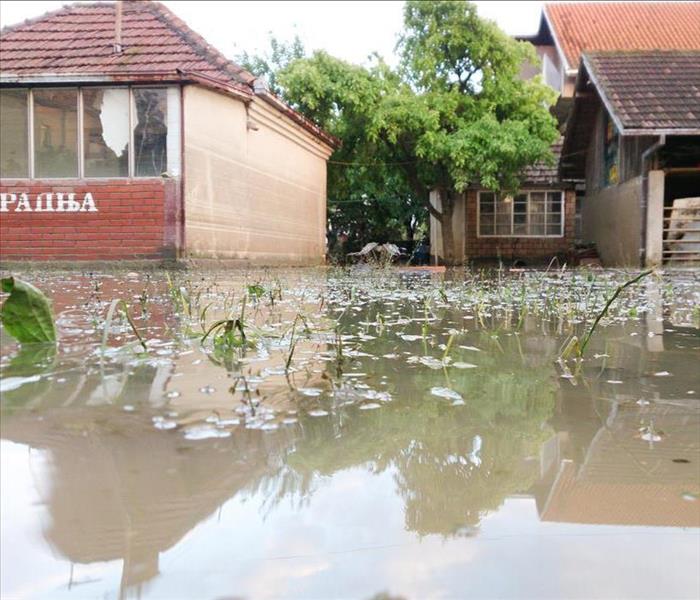 Flood waters can damage your home.
Flood waters can damage your home.
No matter where you live, storms have the potential to cause damage to your property. As recent heavy rains in Yellowstone National Park and other locations indicate, extreme storms have enormous power. One devastating consequence is when flood water becomes so high that it enters your home in Ogden, UT, and causes significant property damage. While many weather events are difficult to prevent, you can take some common-sense precautions that fortify your home against rains and floods.
4 Smart Ways To Minimize Damage From Flood Water
1. Discuss Your Options
Everyone in your household should know what to expect in a flooded building situation. A few timely actions could minimize property damage and increase the safety of loved ones and pets. Children should know about the safest locations to retreat to if water comes into the home, and they should have an understanding of calling for professional help if necessary. The family should also discuss the importance of avoiding electrical features of the home should wires or power boxes become saturated with water.
2. Make a Flood Water Plan
A home plan should go over the evacuation route should a major storm impact your community. Several agencies can help you with this, including the Department of Homeland Security and FEMA, as well as other online resources. Your home should have a solid first aid kit that is kept in a high area of the home, protected from rising waters. An evacuation kit should be kept in an easy-to-access place and should include several days of clean water and some non-perishable food. Also, keep in mind important prescriptions should you need to leave your home for several days.
3. Consider Home Modifications
Most homes have a few weaknesses when it comes to flood preparation. It is worthwhile to take a hard look at your home and see what could be done to prevent water from breaching your house. Some of these actions won't cost much money, such as cleaning gutters and making sure any drains on the grounds are working properly.
You could also waterproof your foundation if it has cracks and install a sump pump if your basement is susceptible to leaks or flood waters. A pump with a battery backup will still work during a power outage, a common occurrence during a storm. You could also have a licensed electrician look at your home in light of flood safety.
4. Know Where To Go for Help
Despite your best efforts, floods might still impact your home and cause water damage. At this time, your best action is to call an experienced water mitigation repair company. Highly-trained technicians will arrive in a matter of hours and begin a proven process to restore your home to its original condition. They will remove any standing water, dry out moist areas of the home, restore or replace damaged items and clean and sanitize the home to prevent mold growth and other potential secondary damage issues.
Smart preparations for your home could prevent flood water from causing extensive damage. Getting experienced professional help could also help minimize the impacts of a powerful storm.
5 Flood Prevention Strategies To Know
7/18/2022 (Permalink)
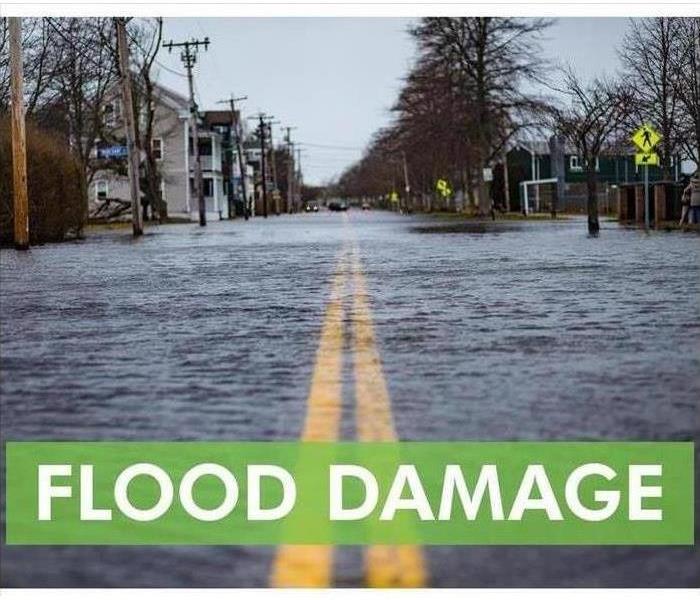 Flood damage can be devastating without a prevention plan.
Flood damage can be devastating without a prevention plan.
For business in Ogden, UT, flood prevention steps may be important when storm season arrives. Many storm damage restoration professionals have recommended tips that may mitigate damage. Here are a few things to consider when preparing your company property against flooding.
Flood Prevention Steps
Believe it or not your landscaping choices may be able to help when it comes to flood mitigation. Slope landscaping away from the building's foundation, and choose local or deep-rooted plants to soak up extra moisture.
If your business is located in an area known for high water during storms, you may want to consider the installation of a retaining wall. A wall or similar installation can help prevent water from flowing into areas where it could pool or cause flooding.
Another tip for flood prevention is to ensure that all your drainage areas are properly covered. This can help keep debris out of the chute which can lead to clogs and other water backup problems.
Regular maintenance of your business property may help mitigate any flood cleaning needed after a large storm. You may want to check areas such as your roof or basement, and ensure that any drainage systems are clear of debris. If you do find an issue it's important to take care of any necessary repairs as quickly as possible.
You may also find it helps to stay informed of the weather patterns in your area. This way you will know ahead of time when a storm is approaching, and be able to take the necessary prevention measures.
When creating your flood prevention plan for your business, consider the use of landscaping, retaining walls, and drainage covers preventing the pooling of flood water on your land. Performing regular maintenance of your company building can also prevent additional damage when the storm hits. It may also help to stay informed of the weather in your area.
Sewer Backups: Expert or DIY Cleanup?
6/7/2022 (Permalink)
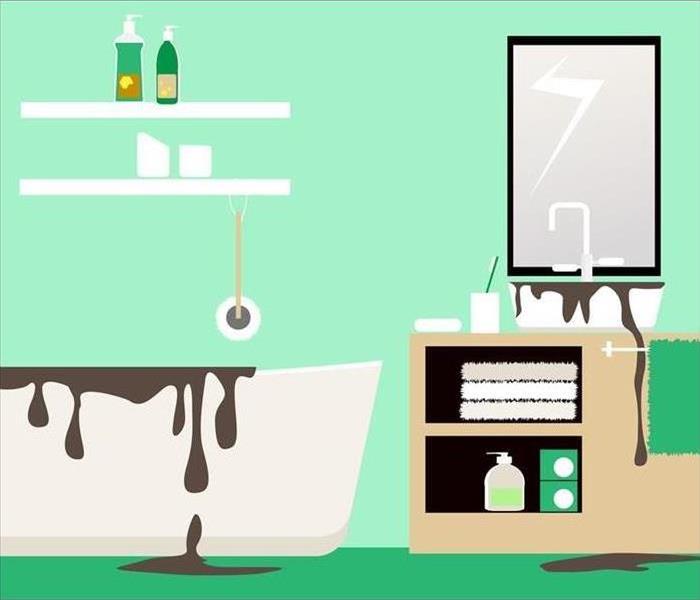 DIY approach can be dangerous. Trust the Specialists and follow our Tips.
DIY approach can be dangerous. Trust the Specialists and follow our Tips.
Sewer backup situations can be dangerous, and it isn't always safe to do cleanup and repairs on your own. For your own safety, you need to know how to recognize and avoid dangerous situations. Use the following information to determine when to hire flooding and water damage experts:
- Always call professionals if the spill has affected multiple rooms in the home, if the backup took place more than a day ago, and if any family members have concerns.
- Sewage often contains contaminants, so you must wear personal protective equipment during cleanup for your own safety.
- All water damage could lead to mold growth. Consider scheduling a mold inspection as soon after flooding as possible.
Steps You Should Take Either Way
Whether you plan to DIY the cleanup of your sewer backup or call professionals to do the job, there are several steps you should take as soon as possible:
- Evacuate any children, animals, and family members who could be vulnerable.
- Contact utility companies to turn off the water, gas, and electricity to your home.
- Provide adequate ventilation by opening doors and windows.
- Remove any items that weren't exposed to water or sewage.
- Add chlorine bleach to standing water to limit the spread of bacteria.
- Contact your insurance company. Take pictures of the water and any damaged property before cleanup professionals arrive.
The work you do at this point can prevent further damage from occurring and may help speed up the process of working through the insurance claim.
Research Causes and Best Cleanup Practices
Clogs are some of the most common causes of the bathtub backup. Hair, small toys, hygiene products, and clumps of soap may initially slow the water as it drains. Eventually, the pressure may cause damage to the pipes, and backups can occur. Roots from trees and shrubs are another common cause of this trouble. Blockages in the sewer main are also a source of backups. When you understand how this type of trouble occurs, you can take steps to prevent damage.
Before you try to DIY the cleanup and repair of a sewer backup in Ogden, UT, make sure you understand the safety risks and the appropriate methods for handling contaminated water and sewage. Do your research before you get started.
Prevent Damage From Ice Dams
5/24/2022 (Permalink)
 Follow our Tips and Prevent Damage From Ice Dams in your Property.
Follow our Tips and Prevent Damage From Ice Dams in your Property.
When temperatures drop below freezing, your home may be vulnerable to ice dam formations. These chunks of ice form at the edge of your roof and sometimes in the rain gutter, preventing the water from melting snow from draining away from your home. The blocked water then has the potential for causing a lot of property damage:
- Wet insulation
- Stains on ceilings and walls
- Mold growth
- Paint damage on the exterior of the home
- Structural damage Inefficient heating and cooling
This damage may travel up your roof as heat from your home continues to melt the snow closest to the surface. The newly warmed water collects near the ice block and adds to the bulk of the dam. The key to preventing this type of damage is preparing your Ogden, UT, home before the first winter storm hits.
Several Ways to Prevent an Ice Dam
One of the most effective methods of ice dam prevention is making sure your roof remains cold. Remember that it's the heat from your home escaping through the roof that causes the lowest part of the snow to melt. Reduce heat loss by filling gaps around light fixtures, filling in holes in the walls and ceilings, wrapping plumbing pipes, and repairing damage to chimneys, vents in the roof, and any leaks in the ceiling and roof.
In addition to preventing dams, you'll also save money on your monthly heating and cooling bills by reducing your energy usage.
Increase the efficiency of those tasks by upgrading the insulation in your attic. You should have between 12 and 14 inches of insulation, but some older homes have eight inches or less. While your focus is on the attic, consider adding ventilation to draw in cool air from outside and expel warm air. Reach out to roofing professionals or technicians with plenty of property damage cleanup and restoration experience.
Invest in an Underlayment or Heat Cable
Many areas of the country require an ice-and-water barrier as an underlayment. If your roof needs to be replaced or upgraded, adding this underlayment is an excellent investment against damage from water and other hazards. You could also install heat cables around the roof to melt snow where dams are likely to form. Make sure that gutters are free of debris, so there is a clear path for water to drain.
Clear Snow From the Roof
If you have a flat roof and a heavy load of snow, remove some of that weight from your roof. Heavy snow presents many risks in addition to an ice dam. It is dangerous to climb onto your roof and the danger increases as the shingles become slick with water, snow, and ice, so check your local home improvement store for an aluminum snow rake with an extendable pole. Start along the edges of the roof and focus on the overhangs. You don't need to clear the entire roof; dams are most likely to form on the edges and overhangs.
Don't panic if you find an ice dam on the roof of your home in Ogden, UT, you can hire professionals to safely remove the dam. Your quick response is the second-best way to prevent serious property damage. For the very best results, use these preventative steps.
Don't Let Sewage Backup Ruin Your Day
2/23/2022 (Permalink)
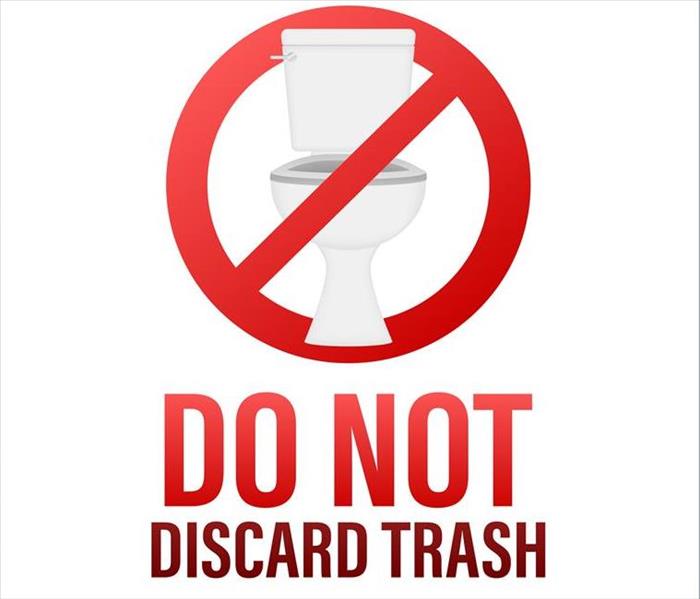 Follow these Tips and Learn more about Sewage Backup and avoid Storm Damage in your Ogden, UT property.
Follow these Tips and Learn more about Sewage Backup and avoid Storm Damage in your Ogden, UT property.
Few water damage emergencies are as unpleasant as sewage backup on your Ogden, UT, property. In addition to the discomfort caused by this type of flooding, exposure to urine, fecal matter, and other sewage causes a lot of damage.
The good news is that there are many things you can do to keep your plumbing system in good condition and prevent damage to your home.
Preventing Sewage Backup
The first step is avoiding sewage from flooding into your home is recognizing the major causes:
Clogs are some of the most common sources of trouble. Whether something has been inappropriately flushed down the toilet or the grease from the kitchen has caused the clog, when there's an obstruction along the sewer line, waste is forced backward rather than forward.
Broken sewer pipes often go unnoticed until sewer cleaning becomes necessary. Pipes may break because the ground freezes and thaws, tree roots grow into the pipes, age makes them weak, or heavy equipment drives over them.
Heavy rains and other external flooding fill the sewer lines up with water faster than they can drain. This running water may also drag sticks, leaves, and other objects down the drain. This heavy load of water forces water from your home to return through the sewer system.
Vandalism is a less common cause of sewer system trouble, but when drainage systems are purposely filled with debris, the results can mean sewage flooding into your home.
The more you know about how and why this trouble occurs, the better you'll be prepared to prevent problems. Once you've gathered a little bit of education, it's time to take action.
Maintenance
The second preventative step involves maintenance and minor repairs. One of the most commonly given pieces of maintenance advice is educating your family about what can be flushed and what should not be flushed, such as diapers, feminine products, and even too much toilet paper. As your family develops good flushing habits, be sure to address seemingly minor issues, such as a running toilet or slow drainage.
Backwater Prevention Valve Installation
These prevention valves allow water to flow away from your home and stop water from getting back into your home. It is possible to install one of these valves on your own, but sewer cleaning and recovery professionals may be willing to ensure that installation is completed without mistakes. The cost of completing this installation may vary based on the difficulty of the installation and the condition of your plumbing.
Professional Inspections
Plumbers and other sewer system professionals have the tools necessary to recognize the warning signs of trouble, such as encroaching roots and structural weaknesses. Remember that catching and preventing trouble is much less expensive than recovery from a sewer backup. Don't wait until you're forced to hire a storm damage and sewer cleanup team in Ogden, UT. Learn how to avoid clogs and other damage, and take steps today to keep your drains, pipes, and connection to the sewer system in great working condition. Recognize when it's time to call in professionals for more significant prevention methods.
Water Damage and the Need for Professional Remediation
1/24/2022 (Permalink)
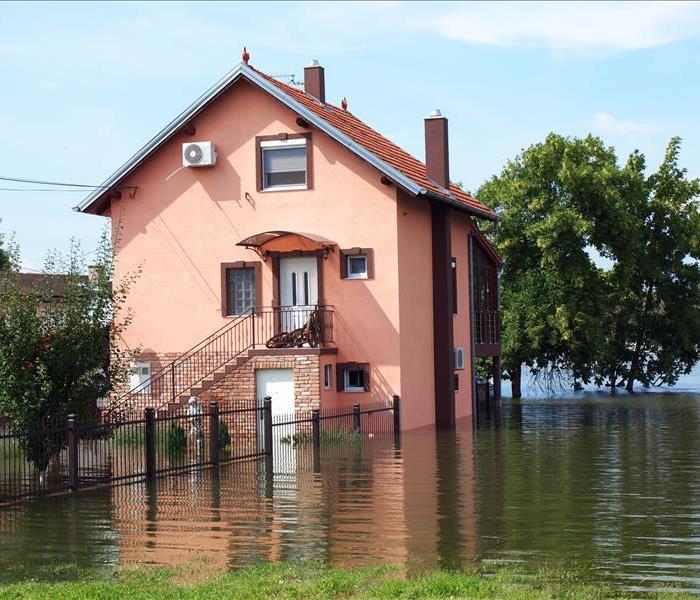 Water damage can vary in contamination levels. The information here presented can be really helpful if you experience this problem.
Water damage can vary in contamination levels. The information here presented can be really helpful if you experience this problem.
Before wading into a flooded basement, street, or property, it is necessary to understand the potential dangers of such actions. Floodwater can contain several contaminants, including:
- Bacteria
- Viruses
- Chemicals
- Biological agents
Before you decide to perform a DIY restoration, contact a restoration service in Ogden, UT. The company can send out qualified professionals to test the water and determine what precautions are necessary to protect both people and property.
Important tips to consider as regards Water Damage
Understanding Water Damage Categories
Every flood is not created equal. Water can become contaminated in various ways, and some forms of contamination are toxic to people and pets.
Professionals use a straightforward classification system to determine water's danger or contamination level. The designation will often correspond to the remediation's difficulty level.
Water loss with the quickest recovery time is category one because it is clean and represents the least risks. However, even category one water damage can evolve into more complex and dangerous categories.
A knowledgeable homeowner will consider the source of a flood to help them evaluate potential solutions. However, a professional is the best solution in most water loss situations.
3 Categories of Damage
Category one water damage is clean water and typically comes from a supply line. In most cases, category one damage is controlled and manageable without the need for professional remediation. However, when it involves a pipe break, the flooding can become extensive, in which case, time is of the essence, and professional interventional might be required.
Category two damage is often referred to as gray water. Gray water is slightly contaminated and can lead to illness if ingested. This type of water contamination usually occurs when clean water seeps through a ceiling to another floor or comes into contact with chemicals or other contaminants on the floor.
Category three water damage is considered the most dangerous. It is called black water. Water in this category is highly contaminated with viruses, bacteria, chemicals, and other biological substances.
Black Water and Its Risks
Because black water is highly contaminated, it is considered a significant health risk. People can become ill by simply coming into contact with the water.
If your home is declared a category three-site, it is best to relocate while recovery operations commence. A qualified remediation team will remove the water and disinfect the property. They will wear full PPE, ensuring their safety.
Category three water damage is not a DIY project. It is necessary to hire a qualified restoration service to avoid any property issues. While the damage can be costly, saving a dollar is not worth risking your or your family's health and wellbeing.
Water damage can vary in contamination levels. The higher the category number, the more dangerous the water. While DIY methods are tempting because of the potential of cost savings, they are not recommended, especially when water damage meets category three standards.
Why You Shouldn’t Drive Down a Flooded Street
10/23/2021 (Permalink)
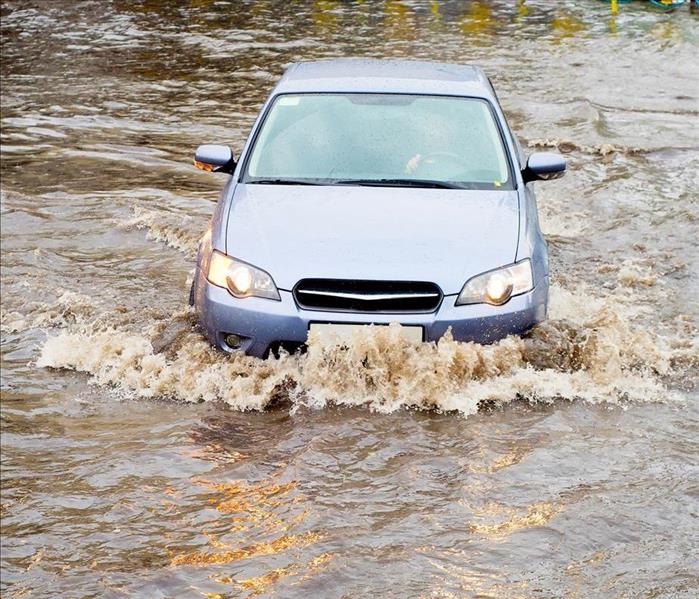 A flooded road can damage your car leading to permanent damage.
A flooded road can damage your car leading to permanent damage.
Floodwaters in Ogden, UT, can arise from heavy rainfall, broken water pipes, or overflowing bodies of water. When you have somewhere you need to be, and you're just ready to get there, driving down a flooded street can be tempting. It may look OK from your steering wheel, but it can actually be perilous. Here are just a few reasons why you should never drive down flooded roads.
1. It Can Be Deeper Than You Realize
It can be challenging to determine how deep water is when you encounter it on the road. Even if it appears shallow, the road surface and underlying ground could have washed away, making the water much deeper.
2. You Can Quickly Lose Control
Six inches of water can touch the bottom of the typical car and cause stalling and even loss of control. Most vehicles will float if they come into contact with one foot of water, and two feet of rushing water can sweep away even large trucks and SUVs.
3. You Can't Always See What's Below
You can't see what's underneath murky floodwaters. Therefore, it can be frightening to think about having no control over where your car is being carried and not knowing what you could run into that could hurt you, your vehicle, or others.
4. It Can Destroy Your Car
Floodwaters can not only do immediate damage to your car, but they can also have lingering effects that may not show up for months. You may have everything from cosmetic damage to engine damage and electrical short-circuiting.
Flood damage experts will tell you to never drive in water that you don't know the depth of. However, there are times when you may already be in it when it floods.
Travel Tips for a Safe Journey in Bad Weather
1. Turn Around
Avoid fast-moving floodwaters. They can carry even large vehicles with ease. Floodwater can even flip a car in as little as 12 inches.
2. If There's No Alternate Route, Take Shelter
If there's no alternate route to take, get out of your vehicle and move to higher ground. Wait until you can safely travel to get back in your car.
3. Travel Slowly
Enter a road as slowly as possible, usually at 1-2 mph). Cross a flooded street at a maximum speed of 3-4 mph. Cars should take turns crossing the road one by one, providing plenty of room and time for each vehicle to pass through.
4. Watch for Obstructions
Floodwaters are usually murky, meaning you won't be able to see what's underneath the water. You will not only have to worry about what is underneath but also what is floating at the surface. Large tree branches, other vehicles, and various other hazards could be floating in the water. You also need to look out for obstacles, such as trees, buildings, and parked cars, that you could run into after losing control of your vehicle.
5. Dry Your Brakes
Once you're out of the water, lightly tap the brakes slowly several times. This will help dry the brakes.
You should avoid traveling down a flooded street at all costs. Now you know why it can be hazardous and how to navigate enough to safely make it to a stop.
7 Steps for Restoring Your House After a Major Storm
8/20/2021 (Permalink)
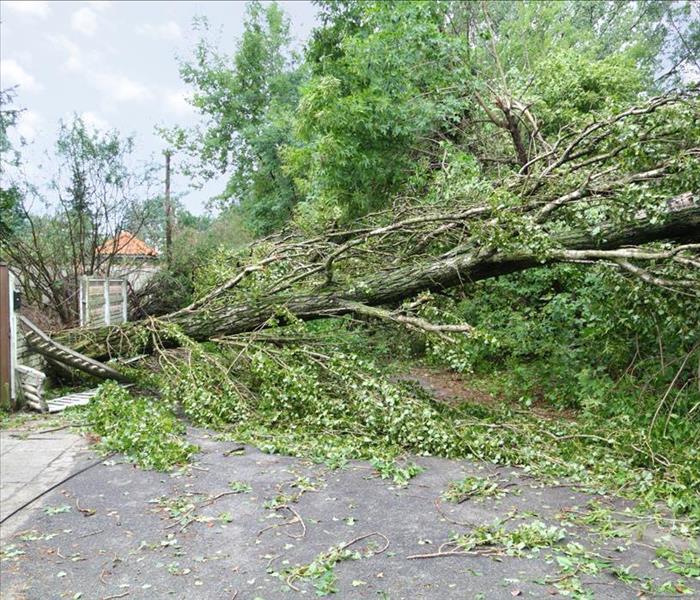 A storm can cause several damages to your Ogden, UT, home.
A storm can cause several damages to your Ogden, UT, home.
A severe storm can quickly wreak havoc on your house, from wind to flooding to fallen trees. You could have a significant job on your hands. You might even have to arrange temporary housing during the remediation process. Of course, you don't want to think about your Ogden, UT, home sustaining any kind of loss. However, being prepared with an emergency plan for the worst-case scenario can keep your family and your home more shielded from the storm and its after-effects.
Prioritize Safety
Safety should always come first. Always wear personal protective equipment, such as safety goggles and a hard hat, when you're performing post-storm cleanup. Don't operate machinery if you're unfamiliar with how to use it safely. Also, be careful of downed power lines, standing water where electricity might be on, and other safety issues.
Document Loss for Insurance
Report the loss to your insurance company as soon as possible to start the claims process. Don't do any cleanup until the insurance adjuster says to do so. They may need to see the damage and take photos of the loss for the claim before restoration begins.
Clear Tree Damage
If you've endured a heavy storm, you're likely to have fallen trees and/or limbs and debris. If you can't safely handle it due to downed power lines or large trees or branches, wait for the professionals to use their specialized equipment and expertise. If you're familiar with this type of cleanup, use a chainsaw to cut large branches into smaller, more manageable pieces and be mindful of more falling debris.
Extract Water
If you've had significant rains and water has infiltrated your house, you'll need to begin water damage remediation as soon as possible. Cleaning and drying the affected area within 48 hours is essential to prevent widespread mold growth and structural damage. The most efficient way to quickly remove standing water by yourself is by using a wet/dry vacuum. If you can't access one of these units in time, mops and towels will also work. If the job seems too challenging for you to handle yourself, flood damage restoration experts can help.
Remove Soaked Items
If flooding has occurred indoors, it's essential to remove all excess moisture. This means removing all soaked materials from the area. These items could include wooden and upholstered furniture, paper materials, even carpeting, and drywall.
Dispose of Ruined Food, Medication, and Cosmetics
Food, medication, and cosmetics that have been exposed to water or heat must be disposed of, as they could be dangerous to ingest or use. Also, if you've had a power outage for more than a few hours, the food in your refrigerator, and possibly your freezer, are spoiled and must be thrown out.
Clean and Dry Everything
One of the most critical parts of cleanup is cleaning, sanitizing, and drying everything in the affected area. Everything must be thoroughly dried within 48 hours. If it's not possible, the item probably won't be salvageable.
Remember these steps in case your home undergoes flooding or any other storm damage. Preparation is key to a swifter restoration after a disaster.
Important Steps To Take If Water Drips From Light Fixtures
7/29/2021 (Permalink)
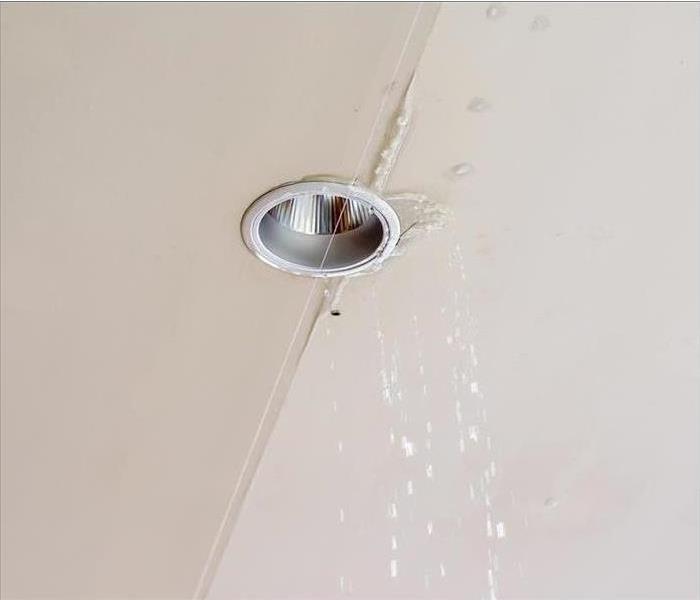 Water dripping from a light fixture is a dangerous problem that must be fixed as soon as possible.
Water dripping from a light fixture is a dangerous problem that must be fixed as soon as possible.
There are certain places in your Ogden, UT, home where you expect to find water, and there are places that will alarm you if water is there. For instance, if you walk into a room and see water dripping from your light fixtures, you know you have a big problem on your hands. Water in a light isn’t a situation you want to take lightly or ignore. With some quick action, you can resolve the ordeal and reduce the risk of widespread flooding.
What To Do First
Water in a light is a dangerous situation, as you know water and electricity aren’t a good combination. For the safety of everyone in your home, make sure you respond to this issue quickly and properly.
- Shut off the power in your home at your breaker box.
- Test to ensure the electricity is off.
- Contact a plumber.
- Contact an electrician.
Turn Off the Power
If you notice water dripping from your ceiling or light fixture, don’t simply turn off the light. You definitely shouldn’t touch the fixture either. Instead, locate the main breaker box in your home and turn off the power to the affected area. In fact, it may be safe to turn off all power to your house. Doing this will eliminate the risk of shock or even electrocution.
Test It Out
To be safe, even after you have shut off the power, make sure there is no electricity flowing through wires and fixtures in your home. With a voltage meter, check whether you detect any current in a dry wire in the home.
Call the Pros
It’s important that you contact the right professionals to help correct this potentially devastating situation. A restoration expert can handle ceiling damage, while a plumber will know how to eliminate the water issue. Also, a trusted electrician will help you install new fixtures without worrying about the risk of shock.
No one wants to see water in a light, but there are fortunately strategies you can follow to help ensure your safety. Act fast and get the right people on the job, and you should be in good shape.
3 Tips for Preventing Mold After a Home Flood
7/15/2021 (Permalink)
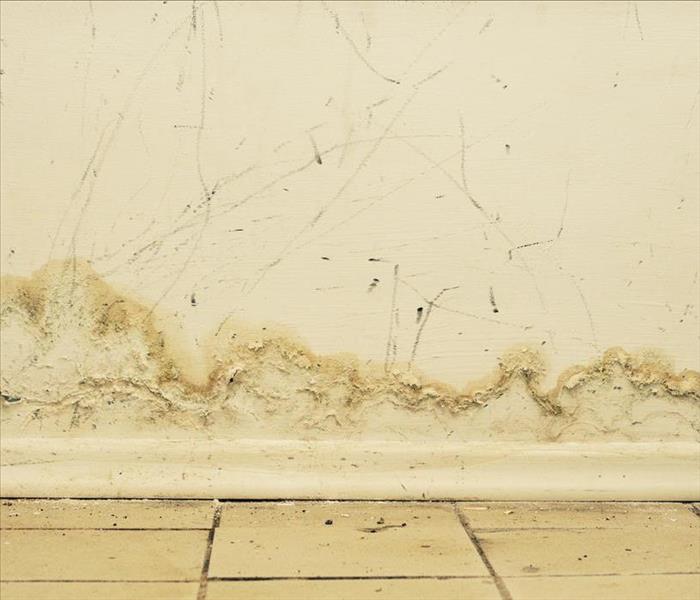 If water damage is not treated properly on time, mold can appear and cause problems.
If water damage is not treated properly on time, mold can appear and cause problems.
The water from a home flood can do severe damage to the structure of your home and its contents; however, the problems don't stop when the water is gone. Mold growth often follows flood damage, unless steps are taken to avoid it.
1. Clean and Dry Your Home Within 24 to 48 Hours
The longer excess moisture stays in your home after flooding, the more likely you are to have issues with mold. As soon as it is safe to enter your home, begin the process of cleaning and drying it out. Because floodwater can contain contaminants and pose other risks, such as electrocution, it is usually a good idea to contact a flood remediation company in Ogden, Utah, rather than attempt to do the job yourself.
2. Increase Air Circulation
High levels of humidity caused by damp surfaces in the home are one of the primary reasons mold growth occurs after a flood. Increasing air circulation can help reduce the level of humidity in your home. Open doors and windows. If it is safe to run your electricity, use fans and dehumidifiers to help with the drying process. If you have ceiling fans, turn them on. You can also add box fans or industrial fans.
3. Remove Wet Contents
Your home will dry out faster if you remove as many of the wet materials as possible. It is particularly important to remove difficult-to-dry items, such as wet carpets, carpet padding, mattresses, and upholstered furniture. If it is not raining, some items can be placed on the lawn to dry out. Items that can not be salvaged should be discarded. Clearing out the contents will also make it easier to complete mold removal, if necessary.
Drying out your home as quickly as possible is the key to avoiding mold growth after a flood. However, always check with authorities to ensure safety before going into a flooded home.
How To Get Help After a Flood Without Flood Insurance
5/28/2021 (Permalink)
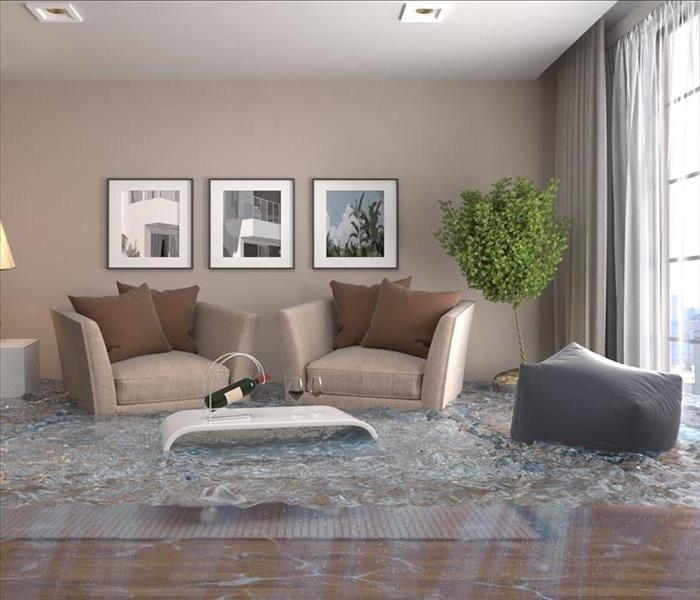 Flood damage
Flood damage
While some areas across the United States are in designated flood zones requiring flood insurance, not every location at risk of flooding has such requirements. When a homeowner experiences a flood in one of these locations, they can feel abandoned by their insurer and government, but depending on the severity of the flooding, you might have options.
If you are unsure of available disaster relief programs in your area, you can reach out to a restoration specialist in Ogden, UT, for guidance. They will likely point you to one of four potential organizations or programs.
4 Potential Organizations or Programs That Will Help After a Flood
1. FEMA Grants
The Federal Emergency Management Agency or FEMA is in charge of coordinating governmental response during natural disasters and more. If the flood you experienced was designated a disaster by the federal government, you might be eligible for grants. To learn more, reach out to a government representative and ask about the designation of your location.
2. SBA Loans
The Small Business Association does not only provide loans to business owners. During times of crisis, the SBA can and will provide loans to qualified applicants without flood insurance. The loans can only be used for your primary residence, and they can come with terms of up to 30 years.
3. Local Emergency Management Services
Every state, county, and local government has its own protocols for responding to disasters, including some programs to help people who need it most. While a local flood plane can be a precipice for a larger scale disaster, flood zones with minimal risks don’t often require preventative insurance. Your local emergency management department, however, might have planned for such emergencies or developed financial aid programs.
4. Nonprofit Organizations
During times of crisis, nonprofit organizations tend to step up to help. These services might offer shelter or one-on-one support to those who need it most.
Flood insurance is nice to have, and it can make the recovery process much easier. However, it is not your only option for finding help.
Mistakes To Avoid After a Flood
2/24/2021 (Permalink)
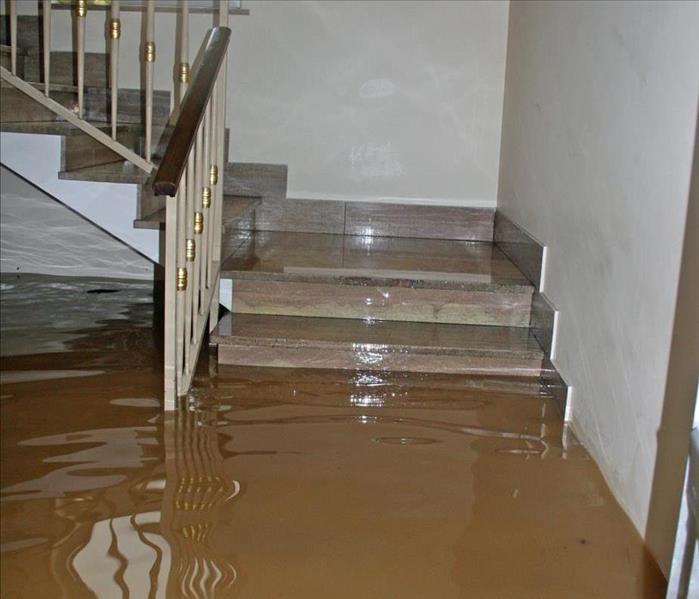 Flood water in a home after a storm.
Flood water in a home after a storm.
Having flood water in your home in Ogden, UT, after a storm can be heartbreaking. It makes sense that you would want to get the problem resolved and get your home back to normal as soon as possible. To do that, though, your gut instinct to rush the process or handle it all yourself may have to take a back seat to better advice. Here are a couple of things you want to avoid when your home is flooded.
2 Things to Avoid After a Flood
1. Handling Remediation Yourself
When you look at your flooded home, you are likely to see many things that need to be done. Rather than marching into the standing water yourself, , though, find storm restoration experts you can trust to handle the remediation. Hiring professionals to take care of your flooding problem has several benefits:
- They already have the appropriate PPE to wear to avoid injury.
- They have the necessary equipment to get rid of flood water efficiently.
- They can repair water damage and rebuild the affected areas.
- They can take measures to treat or prevent secondary damage from mold and mildew.
- They can provide an official assessment to corroborate your insurance claim.
2. Failing To Notify Your Insurance and Mortgage Companies
Your home is important to you, but you're not the only one who has a vested interest in its well-being. Your insurance company needs to know about any damage that is covered under your policy so that it can send an adjuster out and start processing your claim. Your mortgage company expects payment but may waive late fees or extend due dates if you let a representative know that the home has been severely damaged. Neither of these companies can work with you, however, if you don't keep them informed.
You are responsible for your home, but you don't have to always carry that whole burden by yourself. If a storm leaves it filled with flood water, there are many people you can call on for help.
1, 2, 3 Get Rid of Crawlspace Flooding
1/28/2021 (Permalink)
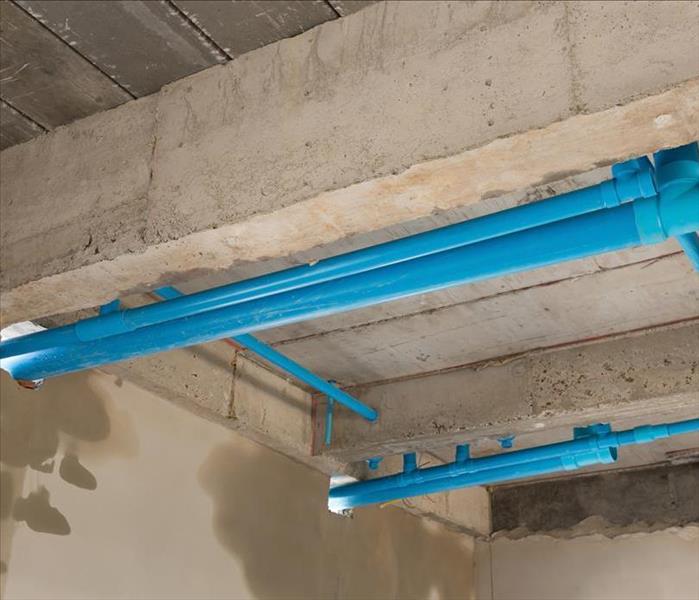 Whether a storm or broken pipe leads to crawlspace flooding, you need to respond immediately.
Whether a storm or broken pipe leads to crawlspace flooding, you need to respond immediately.
When water gets into your crawlspace, there's more at risk than extra moisture and a muddy surface. That standing water can weaken the foundation of the home, encourage the growth of mold and mildew, and attract insects and animals. There are three steps to take when you notice water under the home:
- Identify where the water is coming from
- Remove the water and dry the crawlspace
- Contact professionals
Remember that a wet crawlspace can lead to many expensive issues, so you need to work quickly and thoroughly.
3 Steps to Get Rid of Water in Your Crawlspace
1. Sources of Crawlspace Water
Unless outside flooding has caused the crawlspace to fill up with water, you should look for possible causes including weakness and cracks in the foundation, too much slope toward the home, damaged gutters, or cracks in your water line. Identify the problem quickly, so you can slow down or completely stop the water from rising.
2. Water Removal Methods
There are multiple methods of removing a large amount of water from the crawlspace, and most methods require the use of specialized equipment, such as a sump pump (that handles water) or a trash pump (that pumps water and solid debris) to remove water quickly and then use pumps, vacuums, fans, and dehumidifiers to continue drying the area. If you don't have pumps, contact water damage cleanup and repair professionals.
3. Water Damage Professionals
Although it is possible to evacuate water by hand, it is very difficult to be sure that you've thoroughly dried all of the wood, soil, and other materials under your home. The remaining moisture could lead to secondary problems, such as mold growth. Cleanup and restoration professionals can sanitize the area, address any remaining damage, and take preventative measures. It's also a good idea to call your insurance provider to find out what your policy covers.
Whether a storm or broken pipe leads to crawlspace flooding, you need to respond immediately. If you don't have the right equipment on hand, call Ogden, UT professionals to get started right away.
Getting Compensation for Flood Damage Repair
10/28/2020 (Permalink)
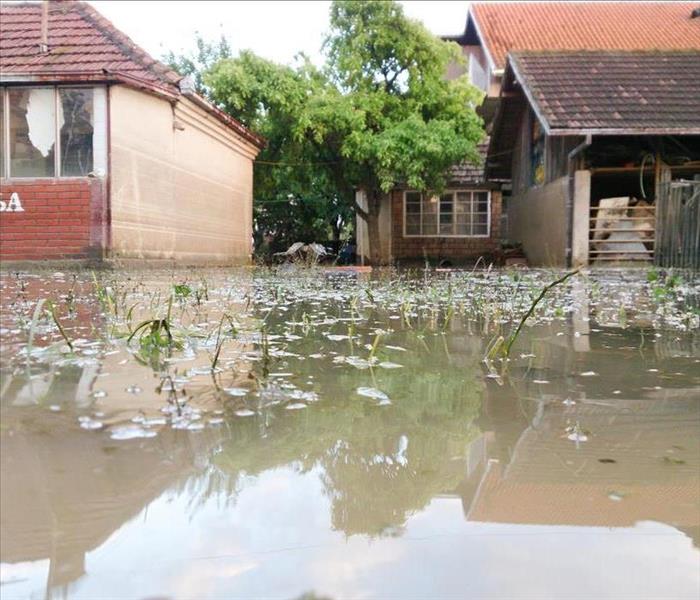 Heavy storms can cause severe damage to your home.
Heavy storms can cause severe damage to your home.
Any heavy storm can do a lot of damage to your home. If a hurricane or other natural disaster hits Ogden, UT, though, the results can be devastating. Whether you have flood insurance or not, you may be able to get assistance to help with expenses through a federal grant.
Getting Assistance Through a Federal Grant
What Is Covered?
Disaster assistance through FEMA may help you cover some of the typical costs that occur after a flood:
- Temporary housing
- Basic home repair
- Vehicle replacement
- Medical or funeral costs
This assistance does not cover the cost to restore your home fully to its previous state or replace every item lost in the flood. It can, however, pay for some of the work done by certified flood experts to help ensure that you have a safe, habitable home to return to.
Who Is Eligible?
In order to provide assistance where it is needed most, FEMA extends eligibility to a broad range of individuals who live or work within the affected floodplain. You can apply even if you don't have current flood insurance. The citizenship of everyone involved is not a factor as long as one member of the household is either a citizen, qualified alien or non-citizen national. Both homeowners and renters, including college students staying in dorms in the area, can apply for aid. Even if you have already started cleanup and paid for some of the services, you may be able to get reimbursed. If your life was affected by the disaster, you are eligible to apply for assistance.
How Do You Apply?
You don't have to determine your own eligibility for relief funds; you simply need to apply for it. To apply for a federal disaster assistance grant, visit the application website or call the FEMA helpline (800-621-3362). You will receive a determination letter that details the money that is available to you or directs you to further action.
Even if you don't have flood insurance, you may be able to receive aid for expenses after a natural disaster. Apply for federal disaster assistance to find out.
Homeowners' Questions and Answers About Nor'easters
8/27/2020 (Permalink)
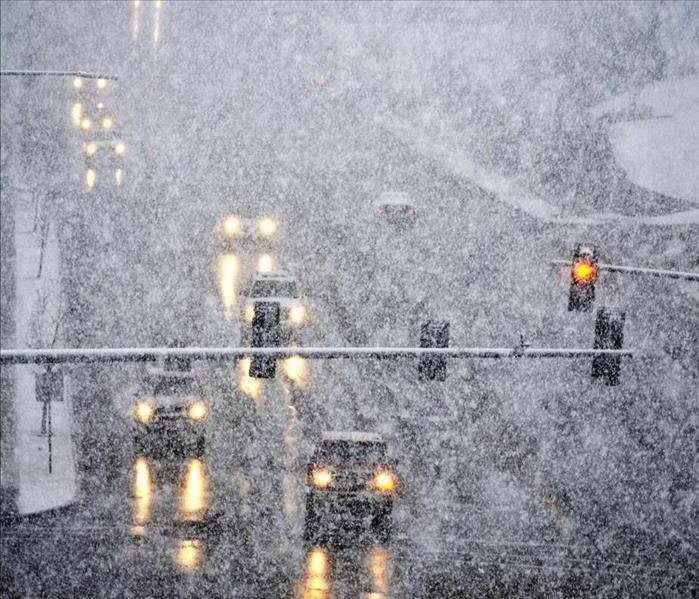 Nor'easter snow storm.
Nor'easter snow storm.
You may have heard the term "nor'easter," but if you haven't spent a lot of time in Ogden, UT, you may not really know what it means.
Facts About Nor'easters
Here's a quick overview of Nor'easter facts:
- Usually involves winds straight off the Atlantic Ocean in the northeast
- Generally associated with winter storms with or without snow
- May happen during any month but are most common between September and April
You aren't likely to experience this type of storm on the West Coast; these storms form when low-pressure areas along the East Coast take on power, specifically in the form of heavy winds. It is possible to experience one of these storms during the spring and summer, but they are really most common during the winter months.
Where Do The Storms Hit?
Most of the time, nor'easter storms form between the states of Georgia and New Jersey within 100 miles to the east or west of the coast. They generally move in a northeast direction, reaching their maximum power near the New England area or even in the Canadian Maritime Provinces. It's common to see areas such as Boston, New York City, Philadelphia, and Washington D.C., hit by the full power of these storms.
Can I Protect My Family and Home?
There are steps you can take to protect your Ogden, UT, home from flooding and other damages as these storms rush through. Begin by thinking of your own safety. Store food and water for three days, at least. Consider other provisions you may need if the power were to go out for several days. Do you have an alternate form of heat, for example?
You may want to talk to your insurance provider about flood insurance. Next, go through the lower levels of your home and move certain appliances or systems to a higher floor, such as the heating and cooling system and electric panels. Regularly inspect the check valves in your sewer system. Reach out to water damage cleanup and repair professionals for other tips specific to your community.
Where Can I Get More Information?
Before the next nor'easter season rolls around, learn more about the risks and the preventative steps you can take. Get information online, from your neighbors, and from the professionals who help homeowners recover from the storms.
How To Create an Emergency Storm Plan
7/28/2020 (Permalink)
 Thunderstorm
Thunderstorm
As a property manager, you juggle a lot of responsibilities. You must ensure that the property is safe for all tenants and that employees are not only doing their job but are also well treated. Having a storm preparedness plan is one way you can protect the building, grounds and all the people involved in an emergency situation.
Commercial Emergency Storm Plan
Building Readiness
Making sure your building is in top shape before storm season begins should be a priority for property management. Storm damage restoration experts recommend a building inspection before any major change in weather to safeguard areas vulnerable to high winds and heavy rain:
- Windows
- Doorways
- Roof
- Basement
When storm season in Ogden, UT, approaches, make sure that you have enough sandbags to slow the flow of water toward the building. Check your backup generator and sump pumps to ensure that they are working properly. The more precautions you can put in place, the better chance your building has of surviving the storm.
People Protection
A good storm preparedness plan revolves around keeping everyone safe and informed. Compile a list of emergency numbers that you can access from anywhere. Keep a hard copy in an easily accessible location just in case your electronic devices fail during the storm. Develop a system for alerting tenants in emergency situations, and inform everyone of this system in writing. It's important to keep the lines of communication open in case you need to evacuate the building or let residents know when they can return to their units. It's also helpful to have a backup plan just in case phone lines are down during or after the storm. Inform your renters and train your staff well so that everyone knows what to expect and what to do.
Having a storm preparedness plan is crucial for property managers. A good plan protects your building and all the people in it.
FAQs About Storm Damage Repairs
5/27/2020 (Permalink)
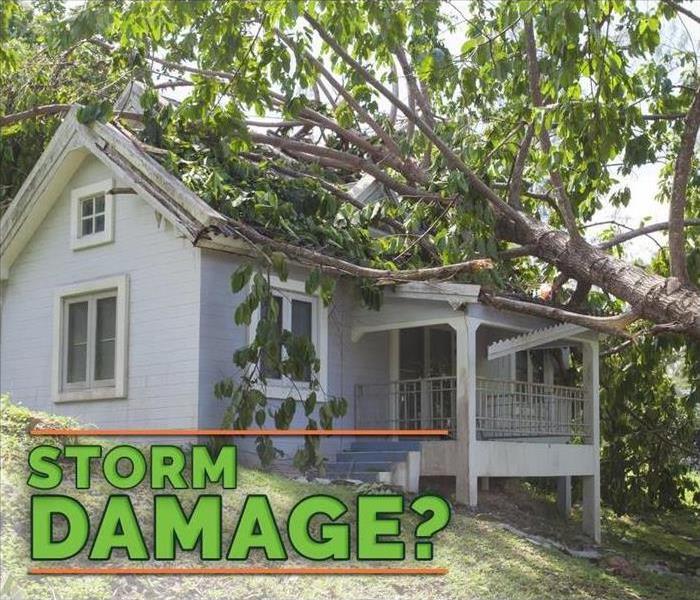 After your home has suffer storm damage you might be wondering what to expect.
After your home has suffer storm damage you might be wondering what to expect.
Sometimes, there's very little notice before a storm hits, but the consequences could last a very long time. When your home has suffered storm damages, including water damage, part of the frustration will be not knowing what to expect.
Common questions include
- Which repairs are handled by professionals?
- Does my insurance cover damages and storm restoration?
- How long will the repairs take?
- Can we stay in our home during the repairs?
The best time to plan for damages and restoration is before a storm hits. Whether you have the luxury of planning ahead or you're already affected by a storm, you'll benefit from the answers to these questions.
What Professionals Handle
Storm damage cleanup and restoration professionals handle a myriad of tasks including extracting water, tearing out sodden materials, drying out flooded areas, removing damaged contents and structural elements, and restoring your home to its pre-storm condition. After inspecting your home, technicians will tell you what to expect.
Insurance Coverage
There are many variables that affect insurance coverage. Get accurate answers to this question by contacting your insurance agent.
Length of Time Spent on Repairs
The amount of time required to clean up damages is affected by how much of the home was damaged, the type of damages, and how many of your belongings need to be repaired. After completing an assessment of your property, technicians can give you an estimate about how long the work will take.
Staying Home or Temporary Housing
Once again, there are several factors that determine whether you can stay home during repairs. If there's minimal flooding, you probably won't have to leave. However, if mold or black water is present, you'll probably want to stay elsewhere during repairs.
It's not uncommon for homeowners to feel frustrated and overwhelmed when their homes have suffered storm damage. The good news is that Ogden, UT, professionals are ready to give you answers to your questions. Contact storm restoration professionals as soon as possible to get the information you need.
4 Common Flood Mistakes To Avoid
5/5/2020 (Permalink)
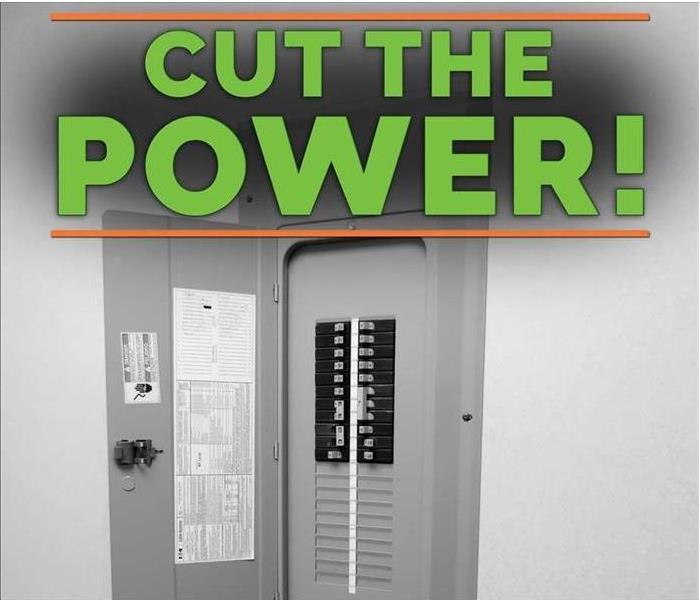 Make sure to turn off the electricity to avoid shocks or fires in Ogden, UT.
Make sure to turn off the electricity to avoid shocks or fires in Ogden, UT.
4 Common Mistakes Homeowners Attempt Making to Eliminate Flood Water
Flooding poses a wide range of personal safety and property damage risks. Homeowners should be aware of the potential dangers of a flooded home in order to make more informed decisions. Here are four common mistakes that many homeowners make when attempting to eliminate flood water.
- Mitigating Before Documenting
If mitigation begins before a homeowner documents the full extent of damage, it may be harder to make a flood damage claim and receive full compensation. Capture the worst of the damage in photographs or videos prior to pumping out standing water.
- Making Direct Contact With Flood Water
Restoration professionals classify flooding as Category Three black water, which may contain chemicals and solid waste. Homeowners and mitigation workers should wear waterproof boots, hip waders, and other personal protective equipment while documenting or cleaning up damage inside a flooded home.
- Turning the Power On or Off
It can be as risky to attempt to shut off a circuit breaker as it would be to turn on a switch or appliance anywhere in a residence that has suffered flood damage. Avoid electrocution by contacting an electrician or utility company and having an expert disconnect the electrical meter.
- Delaying the Start of Cleanup
As soon as damage has been documented and a homeowner has checked in with a flood insurance provider, there is no need to wait to start damage mitigation. Standing water will cause increasing damage to building materials and contents and mold may start to form within just 24 to 48 hours.
These mistakes are easy for homeowners to make. Knowing the risks associated with flood water can reduce the risk of personal injury, problems making a flood damage claim or secondary damage. Homeowners should stay in contact with a flood insurance provider and rely on the expertise of storm and water damage restoration professionals in Ogden,UT.
4 Steps to Take Before a Storm
1/29/2020 (Permalink)
 Storms can be a leading cause for flood damage in Ogden, UT.
Storms can be a leading cause for flood damage in Ogden, UT.
If you are expecting a storm in Ogden, UT, and want to protect your home and family, there are several steps that you should follow. Flood water can cause quite a bit of damage and can compromise your safety, so keep these tips in mind during bad weather.
4 Tips to Follow Before a Storm
1. Have a Safety Plan
One of the most important things to do before a storm is to create a plan. You should know what you will do if the power goes out or, if the storm is severe, what you will do in the case of a flooded building. Consider all possibilities and be prepared.
2. Check Doors and Windows
To protect your home from water damage, you should make sure all of your doors and windows are properly sealed. A loose or broken seal can allow water to get inside, and even a small amount can cause problems. It is a good idea to perform regular maintenance on your home to prevent this.
3. Inspect the Outside of the House
If you have cracks in the exterior of your house, moisture can build up inside of the walls and damage the structure of the building. It can also contribute to the growth of mold. This fungus spreads quickly in dark, moist environments and can cause both discoloration and a musty odor.
4. Create an Emergency Kit
Depending on the type and severity of the storm, the contents of your emergency kit may vary. Some useful items to include are flashlights, radios, batteries, canned foods, and bottled water. Flood water can cause contamination, so you shouldn’t consume anything it touches.
Being prepared can help keep both your family and your home safe. However, if you do experience damage from a storm or flood water, a water damage remediation specialist can help get your home back to its previous condition. They can perform remediation, make repairs and restore damaged belongings.
Getting Standing Water Out of Your Building
10/24/2019 (Permalink)
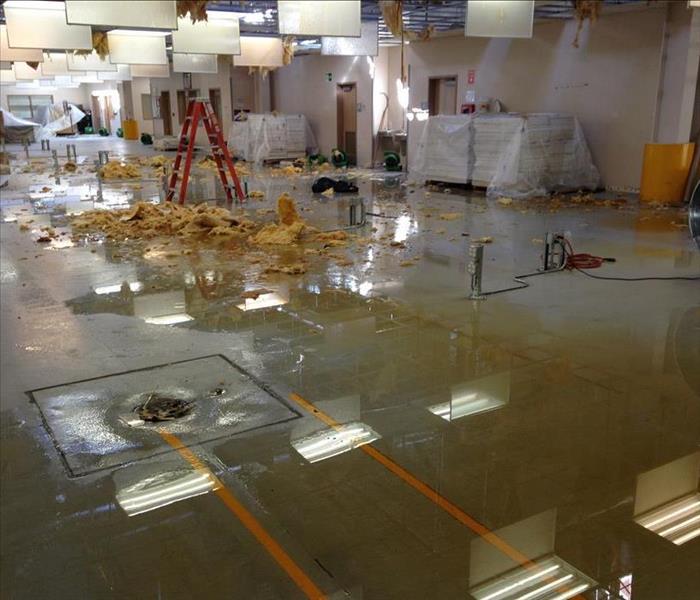 Business in Ogden, UT flooded due to storm that caused the ceiling to colapse.
Business in Ogden, UT flooded due to storm that caused the ceiling to colapse.
When a storm passes through Ogden, UT, you never know what to expect. Your commercial building could be left untouched, or you may have to deal with standing water in your lower levels. When the damage is more severe, you have to know what to do next. Calling in a storm restoration professional can help you react quickly and smartly. Removing standing water from a building requires the use of special equipment and fast actions.
What to expect from a Storm Restoration Team
Standing water can lead to major structural problems and mold growth if allowed to linger in your building for too long. Because the issues can be huge, you need to know what equipment to use. Often, this type of remediation requires the following:
• Truck mounts
• Trash pump
• Dehumidifiers
This commercial-grade machinery can pump out liquids, sludges and solids, which means you don't have to worry about sifting through the dirty water to let the machine run smoothly. Instead, the professionals come in, hook up the hoses and start pumping out your unwanted water.
Know How To Prepare
Once the water has been drained out of your building, you likely don't want to repeat the process ever again. While the professionals can do a good job of helping you dry out the space, it requires a lot of work and can cause your business to lose production time. You can reduce the chances of standing water filling up your building after a storm by installing a sump pump. This pump sits in a hole and works to remove water as it starts to fill up a space. In other words, it works to stop flooding before it leads to standing water.
Storms can often leave you surprised. No one expects to find two feet of standing water in his or her building, but it does happen. If you ever find this unpleasant surprise on your property, you need to hire someone who has the equipment needed to remediate it.
Steps To Prepare Your Home for Winter
9/24/2019 (Permalink)
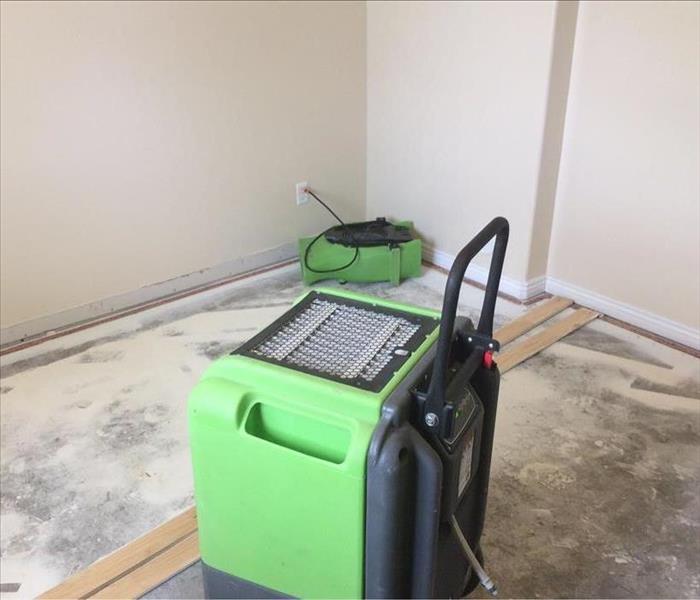 This Ogden, UT home suffered water damage.
This Ogden, UT home suffered water damage.
It’s true that heavy storms can come any time of the year. However, each region has a specific storm season. Before big storms threaten your home in Ogden, UT, there are a few precautions you can take.
Before you secure your home, take a few steps to be sure you and your family stay safe from flood water:
• Make a plan
• Get extra prescription medications
• Put together a pack with water and food for a few days
• Have a way to listen to emergency broadcasts if the power goes out
In addition to completing these tasks, you should prepare your home to keep it safe from water damage.
Schedule Routine Maintenance
Every spring and fall, you should have a professional clean out your gutters and storm drains. This can make sure your system directs flood water away from your home. You should also verify that your roof is in great condition, as even small damage can cause significant problems during a storm.
Check Your Landscaping
Landscaping is more than just a beautiful display of plants. It can also function as a way to prevent having a flooded building on your hands. Be sure that your yard has a slope that takes water away from your home. Retaining walls can help with this.
Furthermore, you should check to ensure that the root systems of your trees are not damaging your foundation. Even small cracks can let flood water in and wreak havoc on your home.
Know What To Do in an Emergency
Some things you can't do until a storm is imminent. For example, you can keep your gas on until big storms are immediately coming. However, you can learn now how to turn off your home’s gas, water main, and power. Be sure that other adults in your home also know how to perform these tasks.
Get ready before a big storm hits Ogden, UT. Follow each of these steps and be as prepared as possible. If you still get water damage, be sure to call a cleanup crew immediately.
Flood Prevention in Large Cities
8/17/2019 (Permalink)
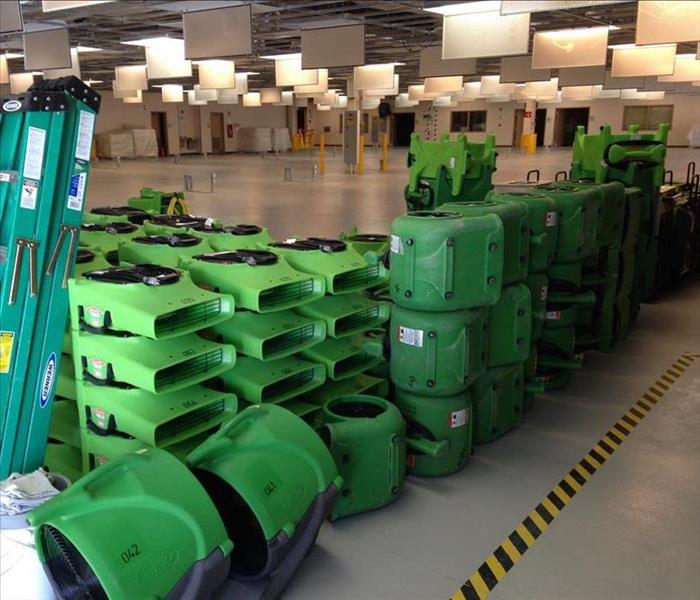 SERVPRO uses the proper drying equipment to restore your business after suffering flood damage due to heavy rains.
SERVPRO uses the proper drying equipment to restore your business after suffering flood damage due to heavy rains.
High water levels after a storm can cause severe flood damage. Lowlands and coastal areas are particularly vulnerable.
Many paved areas do not have proper drainage, which can lead to a buildup of water on city streets. Even traditional levees and dams are insufficient.
While an emergency restoration services company can help with flood cleanup, preventing storm damage entirely ensures that businesses continue running after a weather disaster. That is why some cities have implemented advanced technologies to keep out floodwaters.
Advanced Technologies in Large Cities to Keep Out Floodwaters.
Oosterschelde, Hagestein Weir and Maeslantkering in the Netherlands
Since 60 percent of Holland's population lives below sea level, it is no surprise that the Netherlands is known for its incredible flood prevention systems. One of these is called the Oosterschelde, or the Eastern Scheldt Storm Surge Barrier. These movable gates helped lower the tidal height.
The Hagestein Weir, meanwhile, is a movable dam that blocks high water from the Rhine River. It features two arched gates that can be rotated open or closed. This weir has been in place since 1960 and has inspired similar structures around the world.
A more modern structure is the Maeslantkering, or Maeslant Storm Surge Barrier. It features tanks that fill up as water rises. The weight of this water then keeps the walls of the barrier closed.
Watergates in Japan
As an archipelago, Japan is also prone to flooding. The country thus utilizes canals and sluice-gate locks. It also has numerous water gates that contain hydraulic motors. These gates can thus continue running during power outages.
Thames Barrier in England
The Brits created a hollow steel barrier to block high water from the Thames River. The revolving gates typically remain open so ships can get through but close during major storms. Perhaps some of these technologies will eventually make their way to Ogden, UT. In the meantime, property owners will have to rely on more old-fashioned techniques to stop flooding and prevent the need for storm cleanup.
How To Deal With Residential Water Damage
7/8/2019 (Permalink)
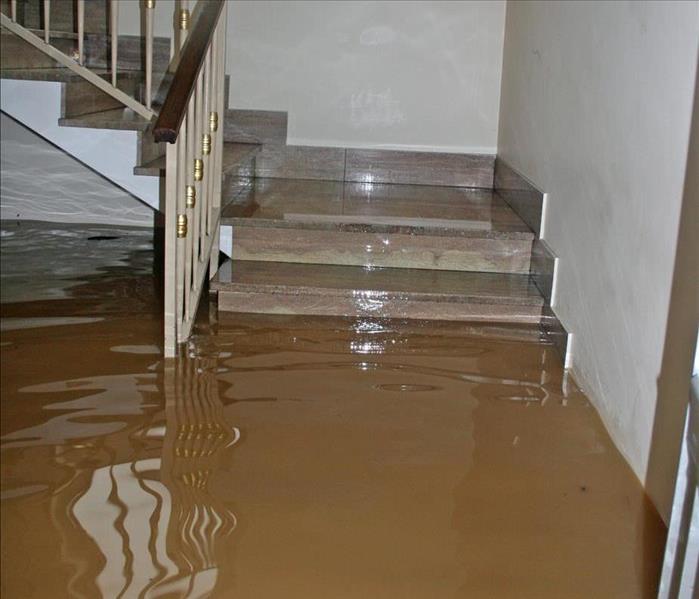 Dealing with water damage in an Ogden, UT home
Dealing with water damage in an Ogden, UT home
Dealing with water damage in Ogden,UT, can be very stressful. You want to get your home back to normal as quickly as possible, but you don’t want to put your loved ones or yourself in danger.
Types of Water
In general, the source of the water determines how safe it is. There are three classifications of water:
- Clean water (uncontaminated — water from sinks, rainwater, etc.)
- Gray water (potentially contaminated — water from aquariums, appliance drains, etc.)
- Black water (contaminated — flood waters, sewage pipes, etc.)
Note that water may begin as one type and become contaminated after it has been exposed, usually within two days. After two days, clean water should be treated as gray water and gray water should be treated as black water.
Treating Water Damage
The restoration process varies depending on the type and amount of water present but generally follows a similar pattern: evaluation, water removal, drying, cleaning and replacement. Pumps and wet/dry vacuums are used to extract most of the water. Then dehumidifiers, air dryers and fans can be used to remove any remaining water. With cases of gray and black water, cleaning surfaces after they are dry is particularly important. Depending on the material, this is done with sanitizing, disinfectant, antimicrobial or antibacterial solutions. After everything is clean and dry, it may still be necessary to replace some things, such as drywall or carpeting. Restoration specialists can help you through the entire process.
Secondary Concerns
In addition to the primary damage, there are other dangers to be aware of when dealing with water, namely electricity and mold. Water and electricity are an extremely dangerous combination. If any appliances or wiring are near the water, do not approach the area until it has been cleared by an electrician. While electrical problems arise immediately, mold takes a little longer, usually two or three days, to appear. Once it does, though, it can spread quickly and further damage your home.
Water damage is a fairly common problem, and with the right equipment it can usually be remediated. However, if not addressed quickly it can lead to more damage.
3 Alternatives to Sandbags
2/11/2019 (Permalink)
3 Alternatives to Sandbags
Your commercial building in Wolfcreek,UT, is likely built to withstand common weather conditions in your area. If a big storm hits, though, are you prepared? Many businesses rely on an old, faithful solution - the sandbag. You can protect your building faster and perhaps more effectively, however, with one of these three newer products on the market.
1. Water Dams
Did you know you can actually use water to fight storm runoff and prevent flood damage? Instead of lugging out heavy sandbags when you need extra protection for your building, you simply your water dam where you want it and fill it up with water. Water dams are easier to use than sandbags, and they can be stored easily, too. Just empty them, dry them and stack them in a closet. You can create small walls that are 20 inches high and about six feet wide, or you can surround your building with a temporary water gate that is several feet tall.
2. Miniature Levees
A levee is essentially a wall that blocks water. Traditionally, they are used by municipalities to protect entire cities. You can construct your own levee on the sides of your building that are most prone to flooding. You can build a wall of synthetic materials that blocks water, or you can go the more natural route and construct what is basically a large sandbag.
3. Synthetic Dams
Another innovation flood mitigation experts suggest for damage prevention is a synthetic dam. These flood dams can be placed where flooding usually occurs. As long as there is no water in the area, they remain compact. When water comes into contact with them, however, they absorb it and swell, creating a barrier between the rising waters and your building.
The sandbag has proven a reliable deterrent against flooding, but there are easier products on the market to use and store. You may find that one of these newer options has benefits that sandbags lack.
Reasons Not To Overlook Your Crawlspace After a Flood
9/18/2018 (Permalink)
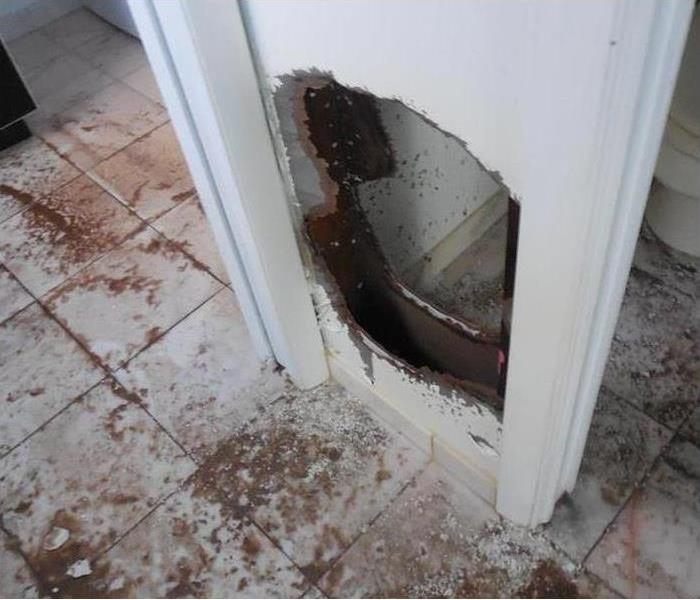 Severe flooding damage caused by storm in North Ogden, UT
Severe flooding damage caused by storm in North Ogden, UT
It’s hard to miss the outward damage of a home flood. However, one place where damage often goes unnoticed is in the areas beneath your home. Designed to allow access to wiring and plumbing, the crawlspaces beneath your home are often the most susceptible to flood damage. Mold, mildew or even insect infestation can result from lingering water damage. When choosing a restoration company in North Ogden, UT, look for one that understands the importance of this often-overlooked area.
How Does a Crawlspace Get Damaged?
When house flooding occurs due to storm damage and rising waters, it’s understandable that low areas like crawlspaces would be impacted. However, there are several other ways besides a home flood these areas can fall prey to water damage. They include:
- Kitchen waste line leaks
- Sewer drain line leakage
- Improperly installed gutter downspouts
- Rising water table
Even water seepage from overwatered plants can get into a crawlspace and cause a host of problems.
What Are the Long-term Effects?
Like any area exposed to water, a crawlspace is susceptible to mold and mildew. If HVAC ducts run through a crawlspace dampened by house flooding, the result can be moldy air blowing through your home. Humidity from the moist areas left by a home flood can warp sub-floors, creating a cascade of damage and expense.
What’s the Solution?
Venturing into a moist crawlspace is often a bad idea. These areas require special cleaning apparatus and even masks for safe remediation. Instead, look to an experienced flood restoration company in North Ogden, UT, to clean up the damage and prevent further problems using tools like sump pumps, dehumidifiers and even special insulation.
Your crawlspaces may not be very visible, but they are important to your home’s structural integrity. Don’t let flood water or storm damage destroy them. Include your crawlspaces in your flood cleanup and rest assured your home is secure.
Protecting Yourself From Floodwater Hazards
7/28/2018 (Permalink)
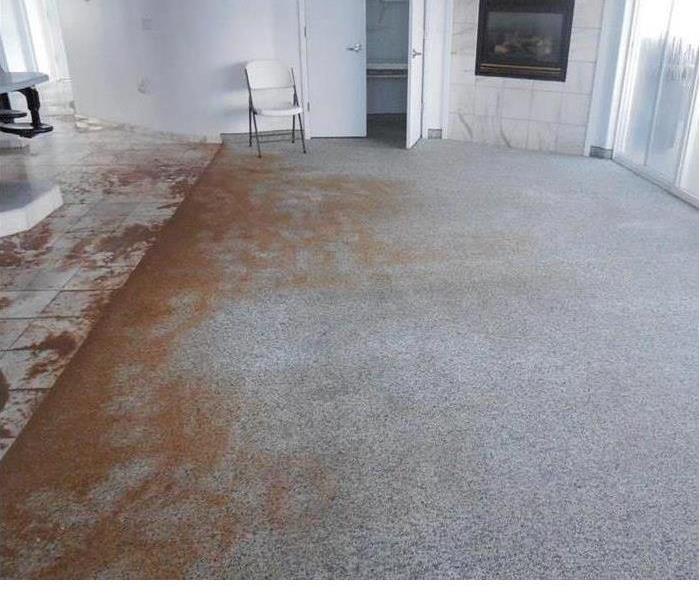
If you’ve never experienced flooding in your Ogden, UT, home, it’s easy to forget how dirty floodwater from a storm can be. In fact, there are three different categories of water damage. Category 1 (“clean water” from water supply lines, pipe breaks, etc.) and Category 2 (“gray water” from water beds, leaking household appliances, etc.) do not pose as large a threat to health as does Category 3 (“black water”). Black water includes floodwater, which can be especially hazardous due to animal feces, chemicals from lawns, and microorganisms that could cause disease.
Cleaning up after storms and flood damage is unlike cleaning up after lower categories of damage. The main difference lies in how to protect yourself from possible health hazards. Here are some tips for tackling Category 3 flood water.
1. Protect your body. To keep contaminants from entering your body when cleaning up after flooding, use protective equipment such as gloves, goggles, and respirators. Even the type of gloves you use matters. Household gloves suffice for mild cleaners, rubber gloves work better when you’re handling disinfectants like bleach, and heavy-duty work gloves are necessary for touching debris.
2. Remove water and dry things out. You can purchase utility pumps, wet/dry vacuums, and other tools to help remove water. Once most of the water is gone, use dehumidifiers and portable air-conditioning units to reduce any remaining dampness.
3. Decide what to throw out and what to clean. It is best to throw out any items that have been affected by groundwater runoff and sewage spills, as well as any absorbent materials (clothes, pillows, etc.) that have remained wet for a long time. If you have clothes and other items that don’t fit into these categories, you can salvage them through deep, repeated cleanings.
Even if you follow all these steps, sometimes it’s necessary to call restoration professionals into your Ogden, UT, home to help clean up after flooding. Either way, because storm damage includes hazardous Category 3 water, make sure to take precautions you wouldn’t have to take with water damage from Categories 1 and 2.
For more information, please visit us at http://www.SERVPROogdenut.com/storm-flooding-restoration.




 24/7 Emergency Service
24/7 Emergency Service






















